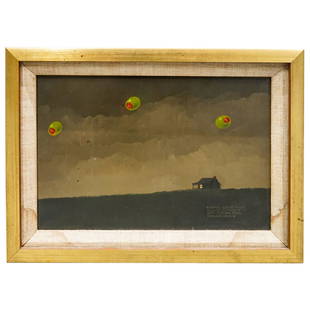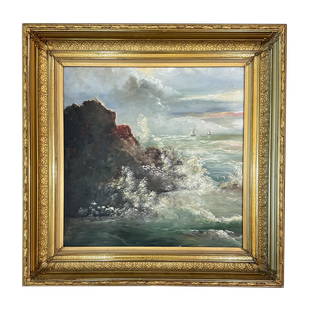
ALFRED SABATTON ROORBACH (b.1850, NJ) Landscape
Similar Sale History
View More Items in Paintings

Related Paintings
More Items in Impressionist Paintings
View MoreRecommended Art
View More





Item Details
Description
Impressionist oil on panel 14 x 10 in., 17 1/2 x 13 1/2 in. (framed). Alfred Sabbaton Roorbach was born in Philadelphia, Pennsylvania, on February 28, 1850, a son of John Ogilvie Roorbach Jr. (1826 – 1913) and Amelia Sophia Lawton (1825 – 1908).Originally from New York, at the time the family lived in Camden, New Jersey, where the head of the household was employed as a bookkeeper. Census records indicate that the Roorbachs moved rather frequently. In 1860, they lived in De Pere, Wisconsin; in 1870 in adjacent Green Bay, Wisconsin; in 1880 in Elizabeth, New Jersey, and by 1900 in Groton, Connecticut. John Roorbach held such positions as a clerk in a lumber office, a photographer, or as a day laborer.By his early twenties, Alfred Roorbach had apparently shown some promise as an artist. On 17 February 1874, the Daily State Gazette of Green Bay noted that “A. S. Roorbach of De Pere is pursuing painting in Chicago under the direction of a skillful artist. An art publication has written in regard to him, ‘One large picture on his easel would not disgrace an old artist.’” By April of the following year a Chicago publication noted that, “A. S. Roorbach, one of the young artists of Chicago, who has gained a warm circle of friends, has gone to New York to spend several years in self-improvement in landscape painting.”By the summer of 1880, the entire Roorbach family had relocated to Union County, New Jersey. The census of that year recorded that Alfred S., age thirty, was employed as an “Artist in Painting,” as was his younger brother George Selden Roorbach (1860 – 1930). A third member of the household, listed as a boarder, was Frank D. Grafflin (age 22), whose occupation was also described as an “Artist in Painting.” The family remained in the area at least through 1885, when they were listed in the New Jersey State Census as living in the Fernwood-Westfield section of Union Township. Alfred Roorbach appeared in the Elizabeth, New Jersey, directory for 1883-84 as an artist located at 216 Broad Street and living in Union. He appeared again in the 1886-87 directory, boarding at 116 Broad Street and under the business name of “Roorbach & Bro.” in partnership with George.In 1879, Alfred Roorbach began exhibiting his work at the National Academy of Design in New York City. He continued to do so every year through 1891, listing his address as of New York even while actually still a resident in Union County. A search of the New York City directories from 1875-76 through 1891-92 failed to turn up a single reference to him, although his brother George appeared for the first time in 1891-92 as “Roorbach, G. Selden. Artist. H. 449 W. 43d.” Alfred, however, may well have continued his art studies in the city during those years. He apparently also became a member of the Salmagundi Club, a prestigious art organization founded in 1871. At any rate, association with the art world in New York certainly contributed more to his growing reputation than listing his address as in New Jersey.The Salmagundi Club opened its first annual black and white exhibit at the Kurtz Gallery in New York on February 13, 1879. The art critic of the New York Herald, in commenting on a number of works on display, noted that “Weirdness, a landscape, by A. S. Roorbach, is a strong bit of work in oil, in which the foreground foliage is full of suggestiveness. The choice of the landscape outlines in the middle and far distance is not happy.” A review in the New York Herald of the Salmagundi Club’s second annual black and white exhibit held at the National Academy of Design in December of 1880 commented that “as many of the club members are well known illustrative artists the collection is worthy of note.” In a listing of exhibitors, the writer observed that “A. S. Roorbach has good little landscapes.”The next annual exhibit of December 1881 drew intense condemnation from the art critic of The New York Times. He railed at length against the increasing use among young artists of thick impasto, dobs of color applied over black and white pigments, and what he perceived as a lack of good drawing or delineation. This may in fact have been a critical review of Impressionism then rising in popularity. After commenting on the bold errors he observed in works by several well-known artists such as George Inness Jr., the writer then had this to say:"Mr. A. S. Roorbach is less bold. In No. 282, Gloaming, a delicate fancy of a twilight landscape, the burglarious colors that have been scaling the walls of the Club with such success confine themselves to modest shades. It is not urged that there is any particular crime against art of the use of evasions like this. It is only maintained that certain fine artistic qualities belong to each one of the branches of art expression, and that it is silly, and, moreover, wasteful of power, to force one branch over into the domain of another. A touch of color such as dilute sepia will give is often excellent. In the right hands even the heaviest impasto of oils can be used with such evident propriety that the critic and his rules are overborne. But the fact that a master can take liberties does not warrant a host of indifferent workmen abandoning the legitimate lines, and showing their weakness doubly by the use of a medium they do not fully grasp."Roorbach was apparently following a more traditional style of artistic expression rather than venturing into new techniques of the day.After 1891, Alfred Roorbach largely drops out of sight. He may have moved with his parents to the vicinity of Groton, Connecticut, as a March 1898 notice in the East Hartford news column of the Hartford Courant provided the following information: “Water Color Exhibit. A. S. Roorbach of Mystic gave an exhibition of water colors at the Raymond Library yesterday afternoon and evening and it will continue this afternoon and evening. The exhibition is given under the auspices of the Art Club. There are about sixty-five water colors and in addition to these a number of pen and ink sketches and some pictures made by a special process.”With that event, the life and career of Alfred S. Roorbach, then forty-eight years old, disappear from the historical record, at least as of this writing. He may have died soon after, or perhaps he just gave up painting and went “off the grid,” to use a modern expression.Brother George S. Roorbach continued as an artist, especially in California where he lived for some years near Santa Clara. He died in Cape May, New Jersey, in 1930.19 George’s estranged wife, Eloise Jenkins Roorbach (1868 – 1961), also gained recognition as a West Coast artist, residing in San Diego.Given the longstanding creative character of this particular family, it seems strange that only a handful of their works have appeared in art markets in recent decades.Source: Joe Hammond (taken in part from his article written for the Winter 2020 issue of New Jersey Studies)
Condition
Good condition
Buyer's Premium
- 25%
ALFRED SABATTON ROORBACH (b.1850, NJ) Landscape
Estimate $400 - $600
9 bidders are watching this item.
Shipping & Pickup Options
Item located in Margate City, NJ, usOffers In-House Shipping
Local Pickup Available
Payment

TOP


















































































![[Custer, Little Big Horn] Eagle Elk, Oglala Sioux Warrior: “I was about 25 the summer we fought Long Hair and I still believed we could drive the white men from our country. I’m a little sad yet about that fight, although it was our finest victory.”](https://p1.liveauctioneers.com/7226/322253/173251540_1_x.jpg?height=310&quality=70&version=1710004847)
